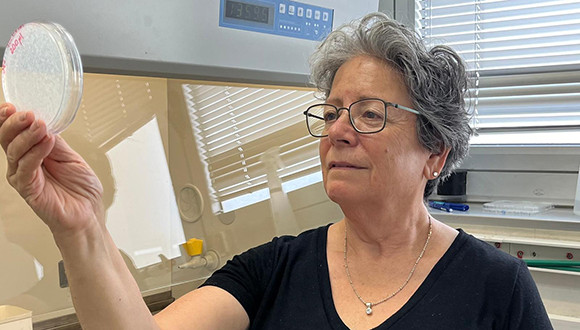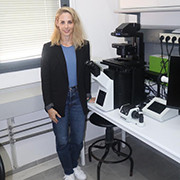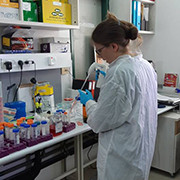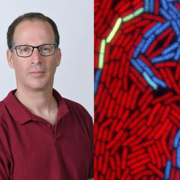How Do Cells Handle Too Many Gene Copies?
Prof. Judith Berman of the Shmunis School for Biomedicine and Cancer Research at Tel Aviv University Explores the Impact of Extra Chromosomes
The genome of each cell in our body contains detailed instructions, or a 'recipe', for the production of proteins, specifying both their types and quantities. These instructions are encoded within the genes of our DNA, distributed across 46 chromosomes in humans. But what happens when, during division, one cell gets an extra copy of a chromosome? Are the excess genes detrimental, putting an extra burden on the cells? Or could cells benefit from the ability to produce extra proteins?
The Detrimental and Beneficial Effects of Aneuploidy
The research of Prof. Judith Berman, from the Shmunis School for Biomedicine and Cancer Research at Tel Aviv University, focuses on trying to better understand this condition, referred to as aneuploidy, in which cells possess extra copies of one or more chromosomes. In a new study, published today in the leading scientific journal Nature, Berman and her collaborators from Charité Medical University in Berlin, Germany, have identified a mechanism used by aneuploid cells that dismantles overproduced proteins, allowing them to continue to thrive. The discovery can lead to the development of new therapies for cancer and dangerous fungal diseases - and helps settle a long-standing question in genomic research about whether aneuploidy is detrimental or beneficial.
"We know that aneuploidy is highly detrimental during the development of the human body," says Berman. The most well-known example is Down syndrome, characterized by an extra copy of chromosome 21 or a portion of it. “In fact, high levels of aneuploidy in human embryos contribute to the 15-20% rate of miscarriages in early pregnancy.”
On the other hand, aneuploidy is common in tumor cells and appears to promote their ability to divide rapidly (which is detrimental for cancer patients). "Extra gene copies in cancer cells can help them ignore the normal laws dictating cell division—for example, they may ignore ‘stop signs’ that should be obeyed to avoid overgrowth. Similarly, aneuploidy can help cells to resist or tolerate the presence of drugs that are intended to stop their growth," describes Berman. “This is true for cancer cells responding to chemotherapy drugs and is also true for pathogenic fungi responding to antifungal treatments.”

Insights from Yeast Research
Research conducted by Berman and other researchers of fungi showed that stresses, such as very high temperatures or exposure to toxins, increase the chances of aneuploid cell division in laboratory strains of brewer’s yeast, a classic easy-to-study model organism for understanding the basic biology of all types of cells that have a nucleus. "Through this process, some cells may acquire extra copies, allowing them to produce higher amounts of some proteins. Many of these extra proteins have no effect, but for some, the excess protein may enable them to grow better in stress conditions that usually inhibit growth."
However, it was assumed that aneuploidy is rare in normal yeast strains, partly because of the high cost of producing excess proteins that can overburden cellular processes. “In addition, elegant early studies found that extra chromosomes were burdensome for yeast cells in normal conditions”. However, a few years ago, a study that analyzed many "real world" yeast isolates, found that about 20% of them had at least one aneuploid chromosome. These 1,011 different yeast isolates were collected from breweries, bakeries, trees, insects, and other environmental sources and differ from one another and from the genetically identical strain used by labs around the world. The surprise was that extra chromosomes in these wild isolates didn't seem to be very detrimental, and the growth rates of the aneuploid yeast strains were similar to those of strains with the normal number of chromosomes.
The Mystery of Tolerance to Aneuploidy
Why did the ‘real-world’ strains tolerate aneuploidy when the lab strain didn’t? In their latest research, Berman and her colleagues solved this riddle by showing that non-laboratory aneuploid yeast strains have a superior ability to degrade the extra proteins. They found that in the natural isolates, the protein levels were reduced by 25%, on average, across the aneuploid chromosomes. In addition, they found that a protein degradation processor, the ‘proteasome,’ is expressed at higher levels in aneuploid than in non-aneuploid yeast.
"The mechanism we discovered provides a deeper understanding of how cells can retain the extra gene copies, and maybe, if the environment changes and they need to survive the new conditions, these extra copies and the proteins they overproduce can come in handy," she says. In addition to providing a new understanding of some of the basic principles of biology, the discovery can be used to develop new therapeutic strategies to deal with the ability of pathogenic fungi and cancer to use their tendency to become aneuploid to overcome current therapies against them.
One important side note of this research, Berman adds, is the importance of examining genetic variability in nature. "For some reason, the clone of brewer's yeast commonly used in labs does not activate the faster protein-degradation mechanism in aneuploids. This is like when we first only had the sequence of one human genome; here, we look at a diverse collection of isolates and try to figure out how different individuals will respond to the same drug or stress".
Now Berman and her colleagues have spearheaded a parallel effort to study about 1,800 "individual" isolates of Candida albicans, a yeast that is a normal component of the human microbiome but that can become a serious pathogen if it infects the bloodstream or internal organs. C. albicans infections typically occur in immune-compromised patients. This study is still in progress, but Berman can reveal that preliminary analysis of the DNA sequencing data suggests that aneuploidy is at least as common in C. albicans as it is in the model yeast. "These results suggest that in nature, aneuploidy can be beneficial for fungi.“
Future Directions and Therapeutic Applications
This current research project, which is funded by a generous European Research Council Synergy Grant, aims to understand not only how yeasts deal with unusual numbers of chromosomes, but also how different isolates, from healthy and sick patients as well as from the environment, respond to the limited number of antifungal medications that are available to treat them. “We think that understanding the role of aneuploidy and other rapid responses to antifungal drug treatments in Candida albicans can also provide insights into similar mechanisms in cancer cells that become resistant to cancer chemotherapy drugs.”





